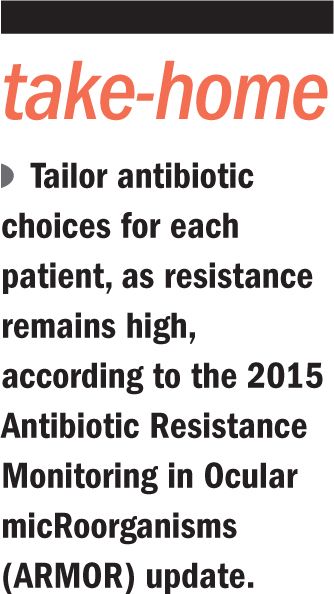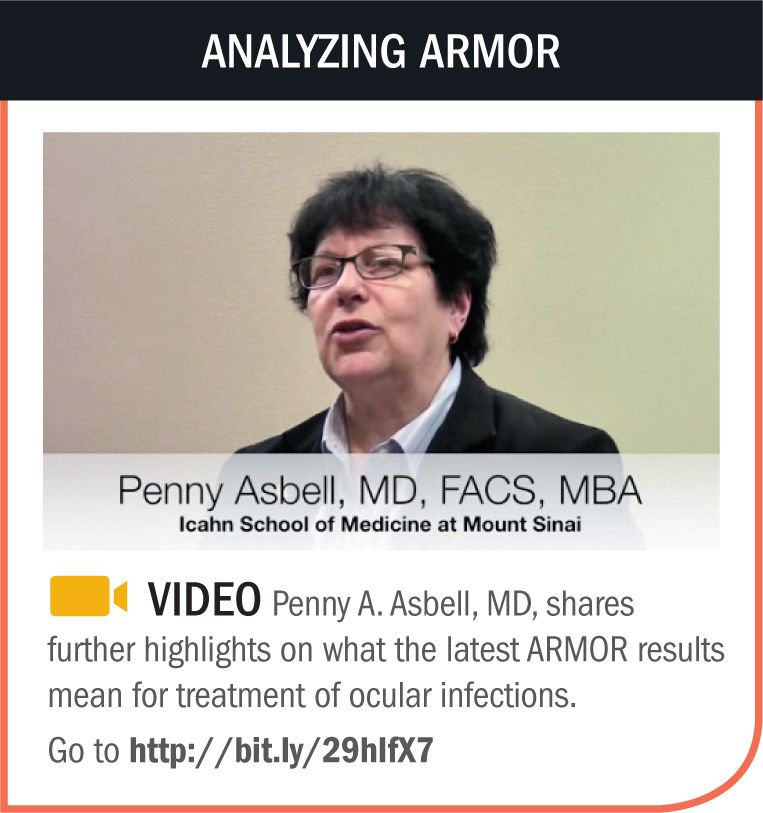Article
What ARMOR update means for ocular infections
Tailor antibiotic choices for each patient, as resistance remains high, according to the 2015 Antibiotic Resistance Monitoring in Ocular micRoorganisms (ARMOR) update.
Reviewed by Penny A. Asbell, MD
New York-Select antibiotics carefully for patients with ocular infections, and consider possible resistance issues, said Penny A. Asbell, MD.
That’s because the latest results from the Antibiotic Resistance Monitoring in Ocular micRoorganisms (ARMOR) study show continued resistance to commonly prescribed antibiotics, said Dr. Asbell, professor of ophthalmology, Icahn School of Medicine at Mount Sinai, New York.

“When we think about antibiotics, we like to think they’re broad spectrum-but they don’t always work,” Dr. Asbell said.
In the ARMOR results reported this year, 20% of Staphylococcus aureus isolates and 39% of coagulase-negative staphylococci were resistant to three or more drug classes, according to Dr. Asbell.
Multidrug resistance remained particularly high for methicillin-resistant S. aureus and methicillin-resistant coagulase-negative staphylococci.
“Isolates of Streptococcus pneumoniae remained susceptible to fluoroquinolones and chloramphenicol, while nonsusceptibility to azithromycin and penicillin was 50% and 38%, respectively,” wrote Dr. Asbell and colleagues.

Although resistance among Pseudomonas aeruginosa isolates remained low in 2015, there was some nonsusceptibility to polymyxin B (7%).
In both 2014 and 2015, Haemophilus influenza was generally susceptible to all antibiotics tested.
One antibiotic that appeared to perform better in ARMOR than others was vancomycin, which basically had zero nonsusceptibility, Dr. Asbell said.
Compounding vancomycin
However, she added, physicians should consider that topical vancomycin still needs to be compounded-making it off-label-and expensive and often more complex to obtain.
In the ARMOR study, isolates from the aforementioned bacteria were collected, and susceptibility testing was performed. Researchers analyzed 441 isolates from 19 U.S. sites.
Researchers determined minimum inhibitory concentrations by broth microdilution for up to 15 antibiotics, and then isolates were classified as susceptible or nonsusceptible.
The ARMOR results should give physicians pause when they prescribe antibiotics, Dr. Asbell said.
“Review the ARMOR data, and make it work for you,” Dr. Asbell said. “Pick the antibiotic that you think will work best for a specific patient. If you have someone who is high risk, elderly, or from a nursing home, think wisely about picking the antibiotic.”
Bausch + Lomb initiated the ARMOR studies in 2009 to analyze antibiotic resistance for the treatment of bacterial infections. The study is the only surveillance program of its kind in the U.S. specific to monitor ocular pathogens, Dr. Asbell said.
Studies like ARMOR provide valuable surveillance information for researchers and physicians, giving a broader view to help guide treatment choices, Dr. Asbell said.
They also provide a wider patient sample, in contrast with smaller studies from single institutions, she added.
Penny A. Asbell, MD
This article was adapted from Dr. Asbell’s presentation at the 2016 meeting of the Association for Research and Vision in Ophthalmology. Dr. Asbell has served on advisory boards for Bausch + Lomb.
Newsletter
Don’t miss out—get Ophthalmology Times updates on the latest clinical advancements and expert interviews, straight to your inbox.





